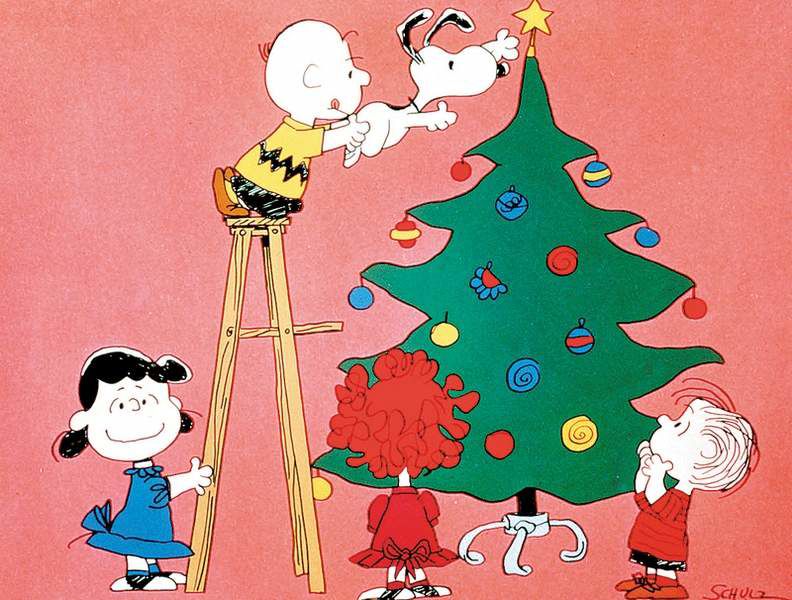Schulz and Co. took a risk, created a classic
Published 4:00 am Tuesday, December 14, 2010

- The “Peanuts” gang transforms a simple little tree into a thing of beauty with a lot of love and attention in “A Charlie Brown Christmas.” The Peabody and Emmy Award-winning animated special will be rebroadcast for the 45th year this month on ABC. It next airs Dec. 16.
Before the steady stream of Emmy and Grammy nominations and Oscar consideration came The Idea — the one that producer-director Lee Mendelson, nearly a half-century later, calls with a certain zest “the best idea I’ve had in my entire life.”
“I’d just made a documentary about the best baseball player in the world,” said Mendelson, 77, referring to his award-winning NBC work about Willie Mays. “So I decided to make a documentary about the worst baseball player in the world.”
Trending
That would be Charlie Brown. Mendelson read a “Peanuts” strip about the perennially losing hurler and thought: Why not make a documentary about the cartoon’s creator?
It turned out to be the best pitch Mendelson ever made.
Mendelson called fellow Northern California resident Charles Schulz — “his phone number was listed right in the book,” the producer recalled — and proposed the documentary. Fortunately, Mendelson says, Schulz had seen “A Man Named Mays” and liked it. “Sure, come on up,” Schulz replied, so Mendelson motored up from San Francisco to Sebastopol, and right there in the heart of wine country, the inspired ideas began to ferment and a 38-year friendship and creative partnership took root.
By 1965, the two men — working with veteran Disney and Warner Bros. animator Bill Melendez — collaborated on their first work, the holiday special “A Charlie Brown Christmas,” a TV show that took chances and defied certain conventions (eschewing even a laugh track) and, ultimately, remained utterly authentic to the trio’s collective vision.
The debut of “A Charlie Brown Christmas” would capture not only the Emmy and Peabody awards, but also roughly half the people watching television across America. And its place in the nation’s holiday hearth has remained fixed ever since.
The special celebrates its 45th anniversary this month, and ABC will air it again at 8 p.m. Thursday. It’s also viewable at abc.go.com.
Trending
As viewers tune in to see a sparse and wilting Charlie Brown Christmas tree — a conifer embodiment of Chuck’s hard-luck seasonal mood — a question about this beguilingly humble cartoon perseveres: Why, precisely, does “A Charlie Brown Christmas” endure?
“I think it has to do with the impact that ‘A Charlie Brown Christmas’ had on the viewer when he or she first saw it,” said Jean Schulz, the late cartoonist’s wife and shepherd of the “Peanuts” estate. “It might have been as a child sitting with parents. Or it might have been adults in their 40s or 50s who were delighted to see a meaningful, adult-themed show that brushed aside the platitudes that surround public dialogue and then passed this on to their children and grandchildren.
“I think these first impressions are very important to us.”
In his recent autobiographical book “Manhood for Amateurs,” the Pulitzer-winning novelist Michael Chabon wrote of the “Peanuts” special’s lasting appeal.
“That show, in its plot, characters, and perhaps above all in its music, captures an authentic bittersweetness, the melancholy of this time of year, like no other work of art I know,” Chabon said.
As for “Mother Goose and Grimm” creator Mike Peters, the greatness of “A Charlie Brown Christmas” springs eternal.
“There has not been a Christmas that we or one of our kids hasn’t bought a sad, pathetic ‘Charlie Brown Christmas tree,’ ” Peters said. “The smallest, most scrawny tree we could find for some cherished place in our home. … As with any great piece of art, as many times that you see it, you take away something new. The humor, the heart, the laughter and the tears.”
Part of the magic of “A Charlie Brown Christmas,” Mendelson says, is the evocative appeal of the music. It was in 1963 that the producer was in a car heading across the Golden Gate Bridge when he heard Vince Guaraldi’s “Cast Your Fate to the Wind.”
Mendelson was struck by the jazz track and contacted Guaraldi, who happened to be a fellow San Franciscan. The producer hired Guaraldi for the planned documentary, and soon after got a call from the composer.
“He said, ‘I’ve got to play this thing for you,’ ” Mendelson recounted. “I said, ‘I hate to hear it over the phone,’ but he insisted. He played (what became) ‘Linus and Lucy.’ It was jazz for adults but still had a childlike quality.
“Right then, I had the weirdest feeling, the strangest thought: that someday, this music is going to have an effect on my life.”
Mendelson and Schulz’s first collaboration was the planned documentary, which featured the cartoonist drawing and discussing “Peanuts.” The strip launched in October 1950 in only a handful of newspapers, but by 1963 had amassed a large national following. The two men shopped their new project to agencies but, to the producer’s surprise, they couldn’t land a buyer.
Early in 1965, however, Coca-Cola came calling. Executive John Allen remembered the “Peanuts” pitch. Now, he had a counter pitch.
“Charlie Brown was getting huge by April 1, 1965, when Time magazine put ‘Peanuts’ on its cover,” Mendelson said. “We got a call from (ad agency) McCann Erickson, which had Coca-Cola as a client. … They weren’t interested in a documentary, but they said: ‘Have you and Mr. Schulz considered doing a Charlie Brown Christmas show?’
“Of course I said yes.”
Mendelson called Schulz with the pitch: “There was a long pause — it felt like an hour, though it was probably five seconds. Then Sparky said, ‘OK, come on up.’ ”
After the initial call to Mendelson, Coca-Cola and McCann Erickson were going to make their decision in one week’s time. Translation: In an era when Western Union was their fastest form of written communication, Mendelson and Schulz had only a few days to cobble together an outline.
They immediately brought aboard Melendez, who several years earlier worked with Schulz on a Ford account featuring “Peanuts” but had never headed the animation of a full-length cartoon. On the clock, the collaboration moved swiftly.
“Schulz’s first thought was to have this revolve around a Christmas play,” Mendelson said. “He also said we should have some winter scenes, outdoor scenes. We also talked about the music: We would have some Beethoven, some traditional, and Schulz had liked so much of the music Guaraldi had written for the documentary.
“I had read ‘The Pine Tree’ by Hans Christian Andersen and threw out the idea of decorating this ‘ugly duckling’ of a tree,” Mendelson continues. “And Bill suggested that we animate some kind of dance sequence and we wanted to have them skate. All these ideas were flying around with no form, all in about an hour.”
Schulz wrote an outline that day. “And that was pretty much what we did,” Mendelson said. “Ninety percent of the show was out of whole cloth.”
Days later, Coca-Cola bought the project. Now the creative trio’s work really began.
Schulz insisted on one core purpose: “A Charlie Brown Christmas” had to be about something. Namely, the true meaning of Christmas. Mendelson and Melendez asked Schulz whether he was sure he wanted to include Biblical text in the special. The cartoonist’s response, Mendelson recalls: “If we don’t do it, who will?”
The corporate sponsor never balked at the idea of including New Testament passages. The result — Linus’ reading from the Book of Luke about the meaning of the season — became “the most magical two minutes in all of TV animation,” Mendelson said.
Mendelson also credits part of the power of the scene to child voice actor Christopher Shea, whose tone of wise innocence, the producer says, fits the moment perfectly.
Several years earlier, young voice actors were cast as “Peanuts” characters for a Ford commercial — this at a time when adult actors were typically cast to voice animated children. “They were 6 or 7 years old when they made the commercial,” Mendelson said of the “Peanuts” actors, “and now they were 10 or 11. But they were still the best voices.” (Melendez, meantime, was drafted to voice the sounds of Snoopy, which were speeded up by 10 times the rate at which they were recorded.)
“We needed an innocent voice for Linus, and a more ‘blah’ voice for Charlie Brown (actor Peter Robbins),” Mendelson said. “Once we recorded the kids, I knew we had something strong.”
Still, with the national network debut just weeks away, Mendelson and Melendez were convinced they were going to become the guys who turned the “Peanuts” national treasure into an animated flop. Says the producer: “We thought we’d ruined Charlie Brown.”
So much had come together in a matter of months, including the opening theme. Mendelson had decided to use a Vince Guaraldi track to help create a bigger opening, but they needed lyrics. All the songwriters they turned to were currently busy, so in desperation, Mendelson sat at the kitchen table and wrote a poem in 10 minutes, he says.
The result: “Christmas Time Is Here,” sung by a Bay Area children’s choir.
“The words just came to me,” Mendelson says of the enduring, much-covered tune.
At one point, McCann Erickson executive Neil Reagan — brother of the future president — was dispatched to San Francisco to check on the show’s progress. The genial ad exec was not encouraged by what he saw but, Mendelson says, kept a lid on his opinions when he returned to the agency.
When “A Charlie Brown Christmas” was screened for CBS executives, they were less than impressed. “They didn’t get the voices. They didn’t get the music. They didn’t get the pacing,” Mendelson recalls. “They said: ‘This is probably going to be the last (“Peanuts” special). But we’ve got it scheduled for next week, so we’ve got to air it.’ “
On Dec. 9, 1965, “A Charlie Brown Christmas” debuted. The special garnered glowing reviews. And half the United States’ TV viewers tuned in.
“The next morning, I walked into my neighborhood coffee shop,” said Mendelson, “and everyone was congratulating me. That’s when I knew we might have something.”
The next year, “A Charlie Brown Christmas” received a Peabody Award, as well as an Emmy for Outstanding Children’s Program. The irony, Mendelson noted, is that Schulz always wrote “Peanuts” with an adult audience in mind — but with enough warmth and distilled emotion and universality that the feature appealed to kids.
The Christmas special also kicked off a creative partnership among Schulz, Mendelson and Melendez that spanned 38 years, dozens of specials and multiple Emmys before Schulz died in 2000.
And still, the meaning of a “Charlie Brown Christmas tree” continues to burn bright in America’s homes.
‘A Charlie Brown Christmas’
When: 8 p.m. Thursday
Where: ABC








